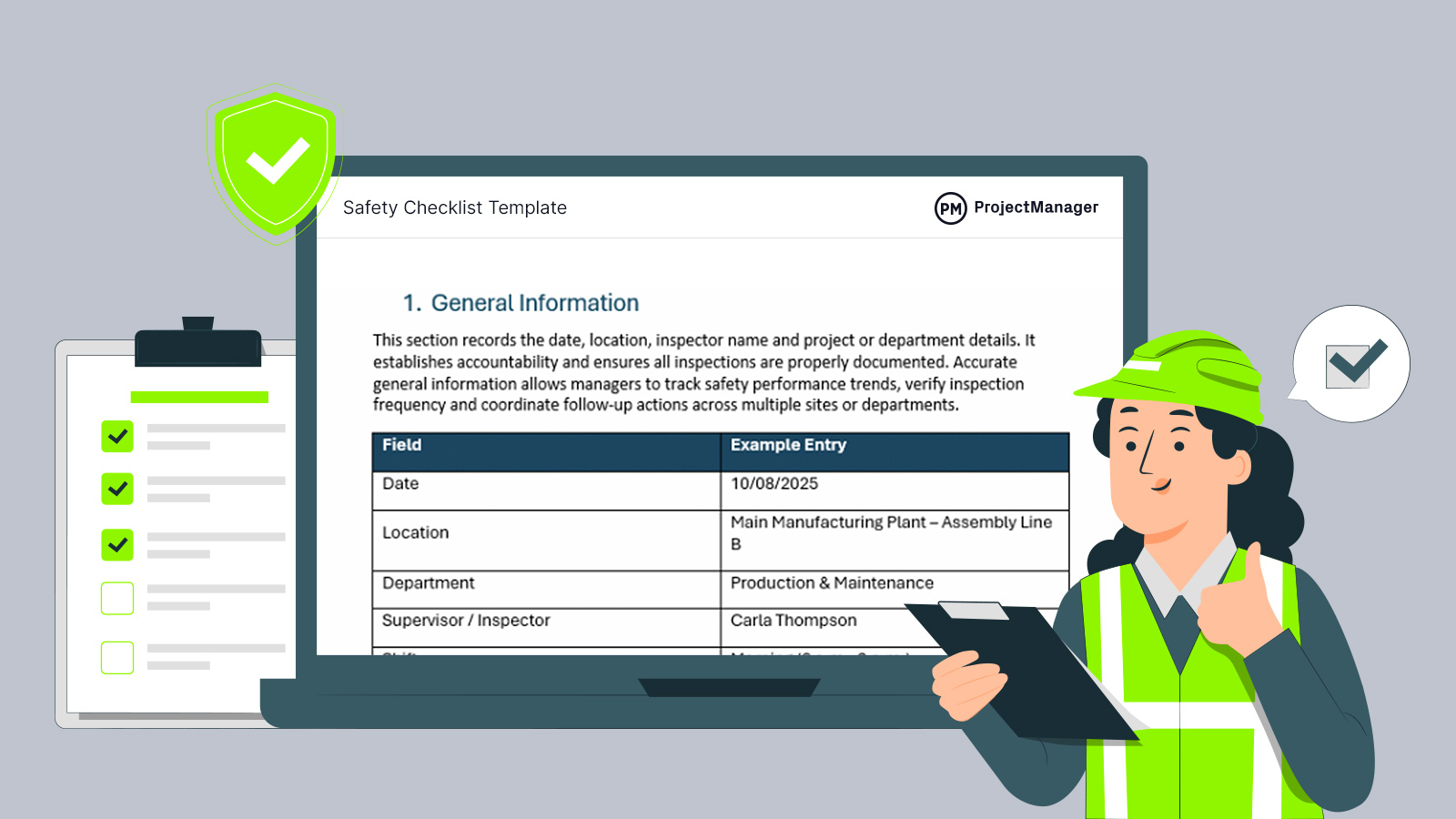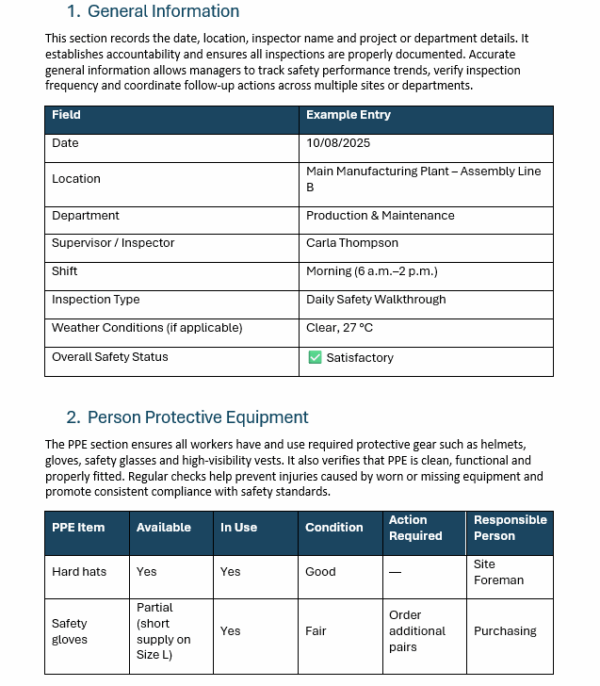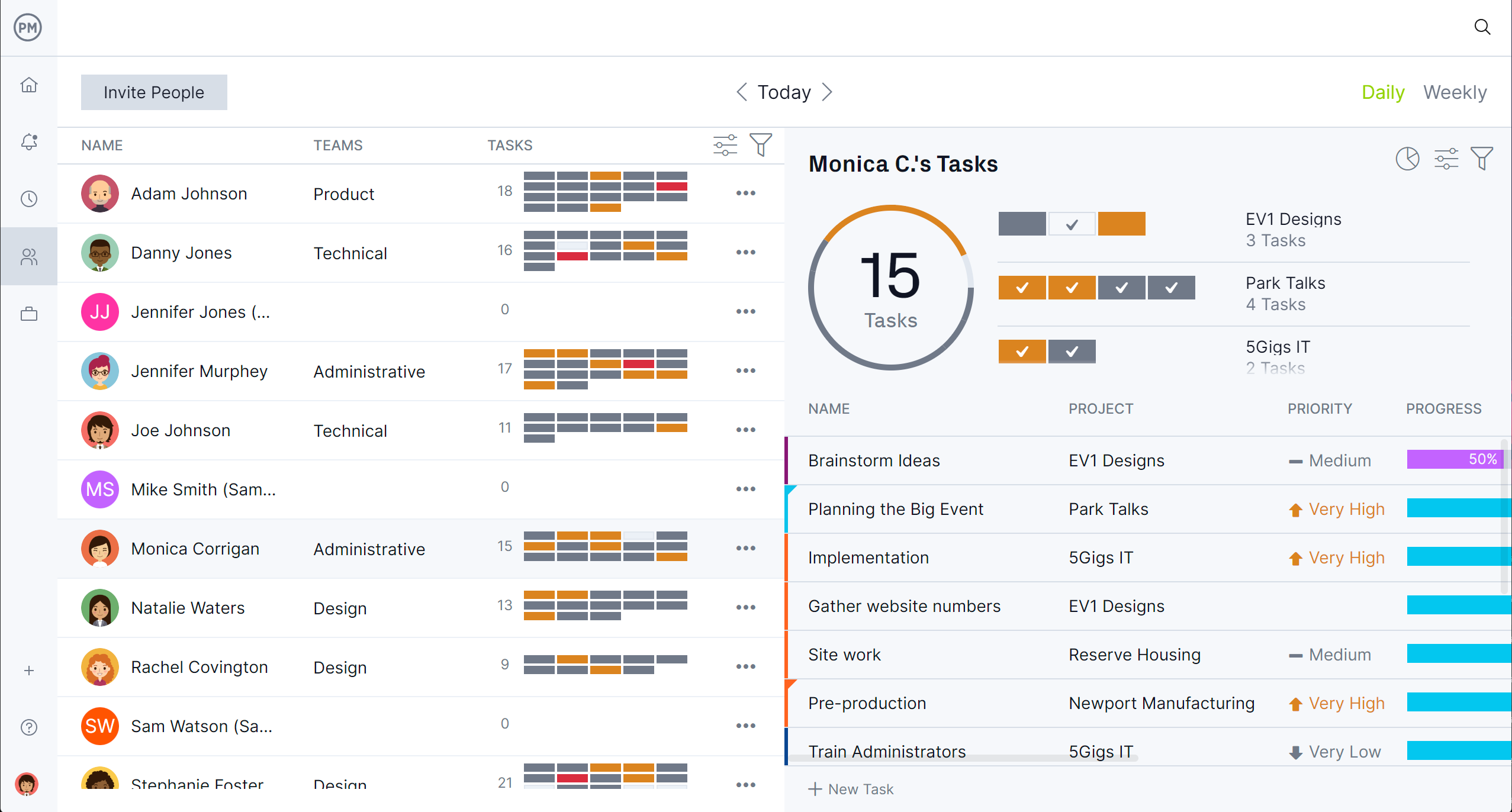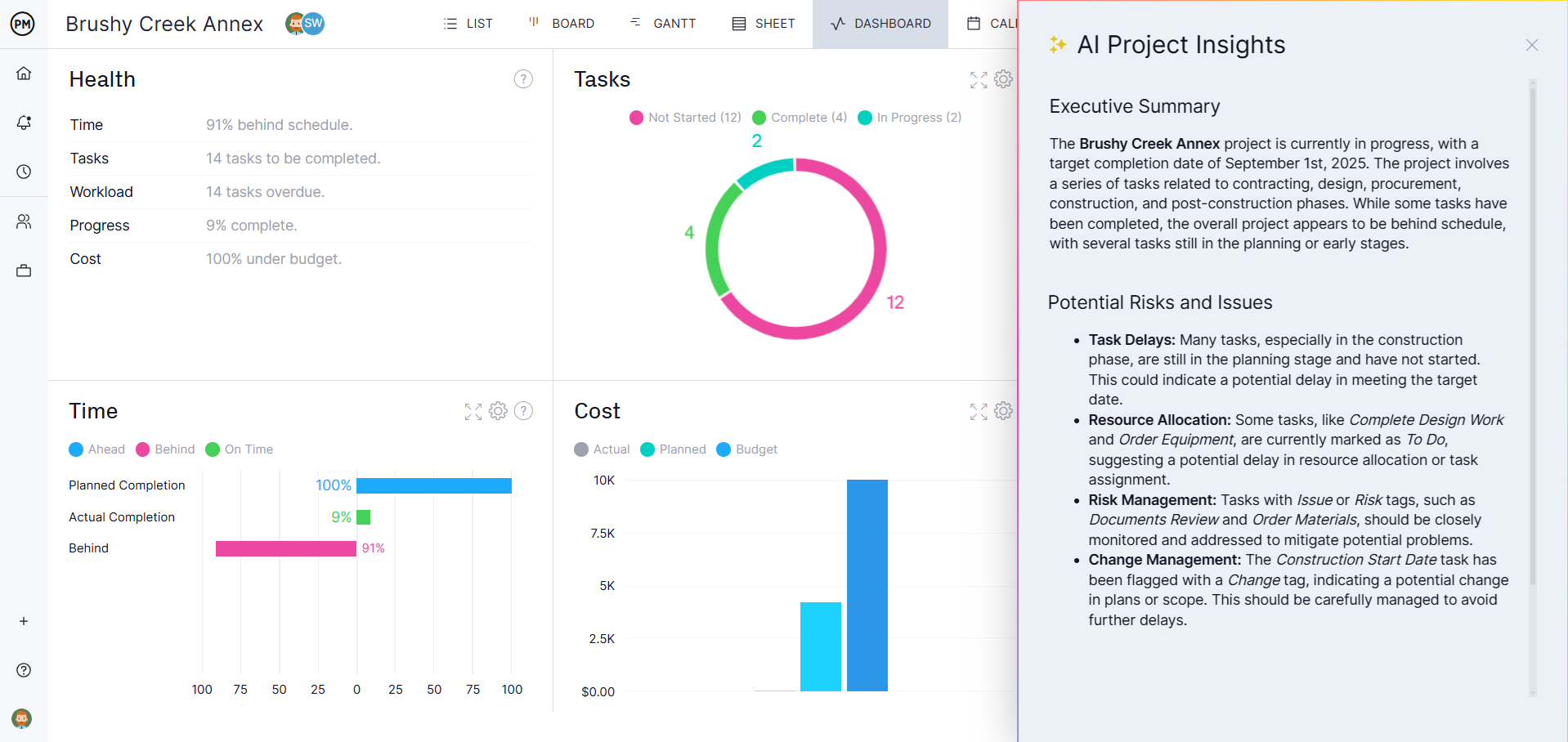A safety checklist is a practical tool that helps teams maintain consistent safety practices on site. Used before shifts, inspections and audits, a good checklist improves compliance, reduces incidents and creates a clear record of safety actions. By standardizing inspections across crews and sites, a safety checklist makes it easier to spot hazards early and take corrective action quickly.
The right safety checklist template saves time by providing ready-made fields for hazards, controls and signatures while remaining easy to customize for specific trades or tasks. Whether printed for toolbox talks or used on a mobile device for real-time reporting, a safety checklist template supports clear communication, faster corrective action and better documentation for managers and auditors.

Get your free
Safety Checklist Template
Use this free Safety Checklist Template for Word to manage your projects better.
What Is a Safety Checklist?
A safety checklist is a structured document that outlines the specific steps, equipment and conditions that must be verified to ensure a safe working environment. It provides a systematic approach to inspecting job sites, machinery and procedures so teams can identify hazards before they cause harm. A safety checklist promotes accountability by assigning responsibility for each inspection item, helping to confirm that safety measures are not only in place but consistently followed.
Construction teams, facility managers and safety officers use safety checklists to comply with regulations and reduce the risk of accidents. These lists can cover everything from personal protective equipment and fall protection to site housekeeping and equipment maintenance. By using a consistent checklist, teams can ensure that no safety step is overlooked and that compliance standards such as OSHA requirements are met during every phase of a project.
Project management software improves the safety checklist process by turning static documents into live, trackable workflows. Teams can create recurring safety tasks, assign responsibilities and track completion in real time. Automated notifications remind crews when inspections are due, while digital recordkeeping eliminates paper logs and simplifies compliance reporting. This helps managers maintain visibility across multiple job sites and ensures accountability through centralized documentation.
ProjectManager is ideal for managing the safety checklist process because it combines planning, tracking and reporting tools in one connected platform. Its interactive Gantt chart lets safety managers schedule inspections alongside construction activities so potential conflicts or high-risk phases can be addressed in advance, including linking dependencies. Teams can attach digital checklists, photos and comments directly to tasks, ensuring every safety item is logged and verified. Real-time dashboards and AI-informed reports give instant insight into site compliance. Get started with ProjectManager today for free.

When to Use a Safety Checklist
A safety checklist should be used whenever workers face physical, environmental or operational risks that could cause injury or damage. These checklists help standardize inspections, verify compliance with safety regulations and prevent hazards before they occur. They’re especially useful in industries where multiple teams, machines and moving parts operate simultaneously, making oversight essential for maintaining a safe workplace.
Construction Projects
On construction sites, a safety checklist ensures every phase of work—from excavation and framing to finishing—is completed safely. It covers PPE requirements, scaffolding inspections, equipment checks and fall protection systems. Using a checklist during daily site walkthroughs helps supervisors identify unsafe conditions early and confirm that corrective actions are taken before work continues.
Related: Corrective Action Plan Template
Manufacturing Operations
In manufacturing, safety checklists are used to monitor equipment conditions, machine guarding, chemical handling and emergency procedures. They help operators maintain compliance with OSHA and other regulatory standards while reducing downtime caused by accidents. Routine use of checklists keeps production lines efficient and ensures that all safety controls are functioning correctly.
Warehouses & Logistics Operations
Warehouses and logistics centers rely on safety checklists to control hazards related to forklifts, material storage and pedestrian traffic. Regular inspections ensure clear aisles, proper stacking and functioning safety barriers. By integrating checklists into daily routines, managers can prevent injuries, minimize product damage and maintain smooth warehouse operations even during high-demand periods.

What Should Be In a Safety Checklist?
A safety checklist should cover every aspect of a worksite or facility that affects employee safety and compliance. It ensures hazards are identified, control measures are in place and safety procedures are consistently followed. Each section of the checklist focuses on a specific category of workplace safety, helping teams conduct thorough and repeatable inspections.
General Information
This section records the date, location, inspector name and project or department details. It establishes accountability and ensures all inspections are properly documented. Accurate general information allows managers to track safety performance trends, verify inspection frequency and coordinate follow-up actions across multiple sites or departments.
Personal Protective Equipment
The PPE section ensures all workers have and use the required protective gear, such as helmets, gloves, safety glasses and high-visibility vests. It also verifies that PPE is clean, functional and properly fitted. Regular checks help prevent injuries caused by worn or missing equipment and promote consistent compliance with safety standards.
Tools & Machinery Inspection
This section confirms that all tools and equipment are in safe working condition. Inspectors check for damage, leaks and malfunctioning parts. Preventive inspection reduces breakdowns, prevents accidents and extends the life of costly machinery, ensuring safe and efficient performance throughout daily operations.
Workplace Environment Inspection
Inspecting the work environment includes checking lighting, ventilation, housekeeping and hazard controls. This section ensures pathways are clear, noise and dust levels are controlled and signage is visible. Maintaining a safe environment reduces the likelihood of slips, falls and exposure-related illnesses among workers.
Related: Best Construction Estimating Software of 2025
Emergency Preparedness
Emergency preparedness covers access to fire extinguishers, first-aid kits and clearly marked exits. It also verifies that emergency procedures and evacuation routes are up to date. Regular checks ensure employees know how to respond quickly in case of fire, medical emergencies or severe weather events.
Training & Signage
This section ensures all workers receive the required safety training and that warning signs and instructions are posted where needed. It also verifies that certifications are current. Keeping training and signage updated helps maintain awareness of potential hazards and reinforces safe work habits across all personnel.
Documentation & Compliance
The final section confirms that all safety reports, inspection logs and permits are properly filed. It helps verify compliance with OSHA and other regulatory standards. Complete documentation supports audits, legal protection and continuous improvement in workplace safety management.
Safety Checklist Template
Download this free safety checklist template for Word to provide a comprehensive framework for daily safety inspections. It organizes essential information, from general site details to personal protective equipment, tools, machinery, workplace conditions, emergency preparedness, training, signage and compliance documentation.

This template helps safety managers systematically track hazards, enforce policies and maintain regulatory compliance. It streamlines reporting, ensures accountability and makes safety oversight easier across all shifts and locations.
Safety Checklist Example
A safety checklist helps organizations systematically inspect work areas, equipment and personnel compliance to maintain a safe environment. Using a detailed checklist ensures that potential hazards are identified and corrected quickly, protecting employees and meeting regulatory standards. This example illustrates how a daily safety walkthrough can be organized across multiple categories, including general information, personal protective equipment, tools and machinery, workplace conditions, emergency preparedness, training, signage and documentation.
General Information
This section records key details about the inspection, such as location, date, supervisor and overall safety status. It ensures accountability and provides context for each safety review, helping organizations track conditions over time and maintain consistency across shifts or departments.
| Field | Example Entry |
| Date | 10/08/2025 |
| Location | Main Manufacturing Plant – Assembly Line B |
| Department | Production & Maintenance |
| Supervisor / Inspector | Carla Thompson |
| Shift | Morning (6 a.m.–2 p.m.) |
| Inspection Type | Daily Safety Walkthrough |
| Weather Conditions (if applicable) | Clear, 27 °C |
| Overall Safety Status | ✅ Satisfactory |
Personal Protective Equipment
This section ensures that all required PPE is available, in good condition and used properly. Regular tracking helps reduce risk, maintain compliance and identify shortages early so the safety team can take corrective action quickly.
| PPE Item | Available | In Use | Condition | Action Required | Responsible Person |
| Hard hats | Yes | Yes | Good | — | Site Foreman |
| Safety gloves | Partial (short supply on Size L) | Yes | Fair | Order additional pairs | Purchasing |
| Protective eyewear | Yes | Yes | Good | — | Safety Officer |
| Reflective vests | Yes | Yes | Excellent | — | Crew Lead |
| Steel-toe boots | Yes | 80% compliance | Good | Reinforce PPE policy | HR & Safety |
Tools & Machinery Inspection
This section helps verify that all tools and machinery are safe to operate, maintained properly and free of hazards. It records the condition, maintenance schedules and corrective actions to prevent breakdowns and incidents.
| Equipment / Tool | Condition | Maintenance Due Date | Issue Detected | Corrective Action | Status |
| Forklift #2 | Good | 20/10/2025 | None | — | Cleared |
| Hydraulic press | Fair | 15/10/2025 | Minor oil leak | Schedule maintenance this week | In progress |
| Electric drills | Excellent | 30/11/2025 | None | — | Cleared |
| Conveyor belt motor | Poor | Overdue | Unusual noise | Replace bearing | Pending |
| Welding equipment | Good | 25/10/2025 | None | — | Cleared |
Workplace Environment Inspection
This section ensures the physical workspace meets safety standards, identifies hazards and tracks corrective actions. Observations include lighting, floor conditions, noise, ventilation and aisle clearance to minimize risks for all personnel.
| Area / Element | Standard Met | Observation | Risk Level | Required Action | Completion Date |
| Lighting levels | Yes | Adequate illumination throughout | Low | — | — |
| Floor cleanliness | Partial | Oil spill near Press Machine 2 | Medium | Clean area and post warning sign | 10/08/2025 |
| Noise levels | Yes | Within acceptable range | Low | — | — |
| Ventilation system | Yes | Air filters replaced last week | Low | — | — |
| Aisle clearance | No | Pallets blocking exit path | High | Relocate pallets immediately | 10/08/2025 |
Emergency Preparedness
This section confirms that all emergency equipment is accessible, functional and regularly inspected. It includes fire extinguishers, first-aid kits, exits, alarms, evacuation maps and emergency contacts, helping staff respond quickly during incidents.
| Item | Condition | Accessible | Last Checked | Action Required | Responsible Person |
| Fire extinguishers | Good | Yes | 01/09/2025 | Update inspection tags monthly | Maintenance |
| First-aid kits | Partially stocked | Yes | 05/10/2025 | Restock medical tape and bandages | Safety Officer |
| Emergency exits | Clear | Yes | 10/08/2025 | — | Floor Supervisor |
| Evacuation map | Updated | Visible | 10/08/2025 | — | Safety Coordinator |
| Alarm systems | Functional | Yes | 07/08/2025 | Perform quarterly sound test | Electrical Team |
| Emergency contact list | Outdated | Yes | 03/07/2025 | Replace with new version | HR Department |
Training & Signage
This section tracks employee training, equipment-specific instruction, hazard signage, chemical labels and incident reporting procedures. It ensures personnel are informed and compliant with safety protocols.
| Item | Compliant | Observation | Action Needed | Responsible Person | Deadline |
| Safety induction training | Yes | All new employees trained | — | HR & Safety | — |
| Equipment-specific training | Partial | Two operators need refresher course | Schedule retraining | Operations Lead | 15/10/2025 |
| Hazard signage | Yes | Clear and readable | — | Facilities | — |
| Chemical hazard labels | No | Faded labels on paint storage | Replace labels immediately | Safety Officer | 11/08/2025 |
| Incident reporting procedure | Yes | Posters visible in break area | — | HR | — |
Related: 9 Free Risk Management Templates for Excel
Documentation & Compliance
This section monitors records, audits and compliance documentation. Proper recordkeeping supports regulatory requirements, internal audits and continuous improvement of safety programs.
| Document Type | Updated | Storage Location | Compliance Standard | Review Date | Responsible Person |
| OSHA Form 300 (Injury Log) | Yes | Digital Safety Folder | OSHA 29 CFR 1904 | 01/01/2026 | Compliance Officer |
| Equipment maintenance logs | Yes | Maintenance Office | ISO 45001 | Monthly | Maintenance Manager |
| Safety meeting minutes | No | Safety Shared Drive | Internal Policy | 05/09/2025 | Safety Coordinator |
| Audit reports | Yes | Secure server (Safety\Audits) | Local Labor Authority | Quarterly | QA Manager |
| Corrective action reports | Partial | Pending upload | Company SOP | 12/08/2025 | Safety Officer |
Free Related Templates
These free templates are designed to streamline construction safety management. Each template addresses a critical aspect of workplace safety and risk oversight, making it easier to plan, document and report safety procedures across your projects.
Construction Safety Plan Template
This template helps outline safety procedures, assign responsibilities and document preventive measures for construction sites. It ensures all hazards are identified, controls are implemented and compliance with safety regulations is maintained throughout the project.
Incident Report Template
Use this template to record workplace incidents, track their causes and document corrective actions. It standardizes reporting and ensures timely communication of safety events, helping prevent future accidents and maintain accountability.
Risk Assessment Template
This template guides users through identifying hazards, evaluating risks and implementing mitigation strategies. It supports proactive safety management by helping teams systematically assess potential threats and maintain a safer work environment.
ProjectManager Is Ideal for Manufacturing and Construction Projects
ProjectManager is built to handle the complexity of both manufacturing and construction projects, offering tools that keep multiple tasks, teams and deadlines in sync. With multiple project views, managers can switch between Gantt charts, kanban boards and task lists to visualize production schedules, construction timelines and workflow dependencies. This flexibility allows for real-time adjustments, better sequencing of operations, and more accurate forecasting of project milestones.
Optimize Resource Management
Resource management in ProjectManager allows you to allocate labor, equipment and materials across multiple projects with precision. In manufacturing, this means tracking machine availability, production line capacity and material inventory levels. In construction, it enables assignment of crews, scheduling of heavy machinery and monitoring of on-site materials.
Built-in workload views, resource allocation charts, team page and automatic alerts prevent overbooking, reduce downtime and ensure that every resource is used efficiently throughout the project lifecycle.

Streamline Tracking
Tracking progress is critical in both manufacturing and construction, and ProjectManager simplifies this with comprehensive dashboards, real-time reports and integrated timesheets. Timesheets allow field operators and shop floor staff to log hours directly from mobile devices, capturing labor costs accurately.
Dashboards give managers a visual overview of production output, construction milestones and pending tasks. Customizable reports provide insights into budget adherence, resource utilization and project risks, enabling proactive decision-making and ensuring projects stay on schedule and within budget.

Related Content
Whether you’re working in construction or manufacturing, a safety checklist helps deliver projects without incidents impacting deliverables. For those who want to expand the lens and learn more, check out the links below on risk management, site management and more.
- Construction Risk Management: An Introduction
- Construction Site Management: A Guide to Site Inspection
- Shop Floor Management: Planning, Scheduling and Control
- Logistics Management 101: Types, Degrees and How It Works with Supply Chain Management
ProjectManager is online project and portfolio management software that connects teams, whether they’re in the office or out in the field. They can share files, comment at the task level and stay updated with email and in-app notifications. Get started with ProjectManager today for free.

